10 Black And White Birds in Michigan
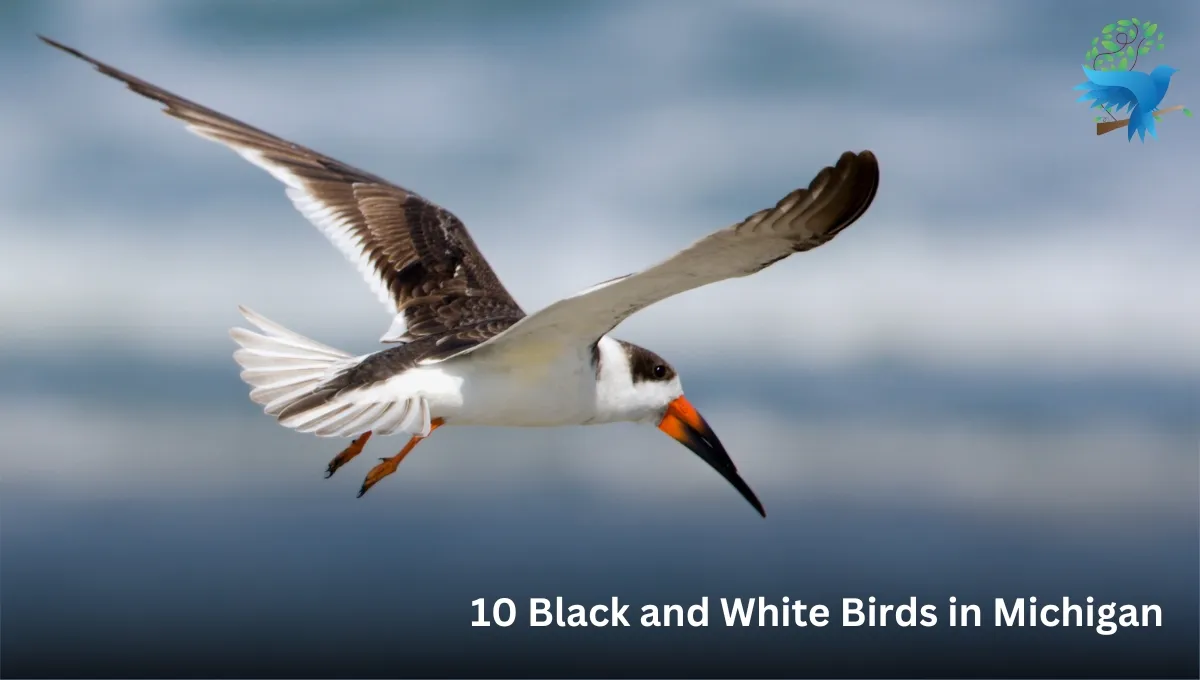
If you are a bird enthusiast, then you might know Michigan is home to a variety of black and white birds. These fascinating birds are mainly found in backyards, gardens, parks, and in open places.
Michigan’s avian landscape is adorned with an array of captivating black and white birds. We will delve deep to learn about the unique characteristics, habitats, and prime locations in Michigan to catch a glimpse of these mesmerizing black and white birds.
In this blog post, we’ll take a closer look at the list of 10 Black and White birds that are found in Michigan backyards. Some of them are:
List of 10 Black and White Birds in Michigan
Black-capped Chickadee

Where in Michigan does it find:
The small non-migratory bird, the Black-capped Chickadee widely found in the northern United States to southern Canada. Commonly, throughout all the parts of Michigan year-round residents and up to Alaska and Yukon.
Description of the bird:
The social bird, the Black-capped Chickadee is mainly recognized by a black cap on the top. Along with it also has a “bib” with white sides to the face. It is well known for its vocalizations. Like the “fee-bee” call and its “chick-a-dee-dee-dee” call. They have a short dark beak, their back is gray and their tail is slate gray.
Size of the bird, size of wings, weight of the bird, beak length:
Size: 4.5-6 inches
Wingspan: 6-8 inches
Weight: 0.3-0.5 ounces
Beak Length: 8-9.5 mm
Habitat and Behaviour:
This type of bird is frequently seen in the woodlands, parks, and suburban areas. Black-capped Chickadee is restricted to deciduous groves.
Mostly, known for their acrobatic flight patterns and joyful chirping. Black-capped Chickadees are commonly known for their behavior as caching.
Diet:
The family of Paridae, a Black-capped Chickadee bird mainly hops along the branches of trees. In search of food, these birds hang upside down or hover to catch the insects in the air. Insects (form a large part of their diet), seeds, berries, and black oil sunflower seeds are offered at bird feeders.
Notable Locations in Michigan for Viewing:
Primarily, these birds can be seen in the wooded areas like Sleeping Bear Dunes National Lakeshore or Hartwick Pines State Park. It is a place where there is an excellent chance to spot these chirpy birds.
Downy Woodpecker

Where in Michigan does it find:
One of the species of woodpecker is the Downy Woodpecker whose appearance is quite similar to the hairy woodpecker, found in North America. But, Downy Woodpecker is not closely related to the Hairy Woodpecker.
The bird can be found throughout Michigan as a year-round resident. These types of birds are mainly known as permanent residents which migrate from the northern part to the southern part.
Description of the bird:
When it comes to recognizing the Downy Woodpecker bird, it is mainly classified as black on the upperparts and wings as well. They have a white back, throat, and belly along with a white spot in the wings.
You May Also Read More: Types Of Woodpeckers in Virginia: A Comprehensive Guide to the 8 Different Species>>>
In addition, adult male woodpeckers have a small red patch on the back of the head. Whereas, the female woodpeckers lack the red patch on the back of their head. Likewise, the juvenile birds display a red cap.
Overviewing the Downy Woodpecker bill it’s short, sharp, and ideal for drilling into bark to find the insects.
Size of the bird, size of wings, weight of the bird:
Size: 6-7 inches (14-17 cm)
Wingspan: 10-12 inches (25-30 cm)
Weight: 0.74-1 ounce (21-28 g)
Habitat and Behavior:
Downy Woodpecker is a part of the family Picidae. They are frequently spotted in the woodlands, parks, and suburban areas. This woodpecker bird gives several vocalizations which include a short “pik call”.
Another call of the woodpecker is the rattle call that sounds similar to a short burst i.e. a bouncing ball. Often, the sound that can be heard while tapping rhythmically on trees is made in search of insects.
Downy Woodpeckers have an undulating flight distinctive feature that can be observed while clinging to the tree trunks or branches in pursuit of their prey.
Diet:
They feed mainly on insects, along with the supplements in their diet with seeds, and berries.
Notable Locations in Michigan for Viewing:
The best places to spot Downy Woodpeckers are Pictured Rocks National Lakeshore or Seney National Wildlife Refuge, State Parks, Nature Reserves, and Wooded Suburban Environments.
Black and White Warbler
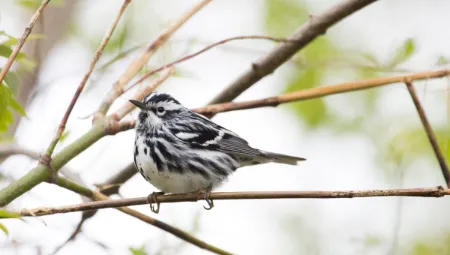
Where in Michigan does it find:
The Genus of Mniotilta, Black and White Warblers are a part of the family Parulidae. This type of bird is a migratory which is specifically found in Florida, Central America, the West Indies, and Northern South America down to Peru.
Warblers are those types of species that occur as a vagrants in Ireland, Faeroes, Iceland, and the UK.
Description of the bird:
The Black and White Warbler’s appearance is similar to its name. These beautiful birds have striking zebra-like black and white stripes.
Warbler possesses a slender, slightly curved bill which is suitable for probing crevices for insects. The vocalization of these birds has a high-pitched song i.e. wee-see. Warblers repeat wee-see at least six times in succession.
Size of the bird, size of wings, the weight of the bird:
Size: 4.3-5.1 inches (11-13 cm)
Wingspan: 7.1-8.7 inches (18-22 cm)
Weight: 0.3-0.5 ounces (8-15 g)
Habitat and Behavior:
Black and White Warbler birds are those types of birds known as migratory species. Generally, these lovely birds are found in deciduous forests. These warblers mainly prefer mature forests and woodlands with dense undergrowth.
The Warblers commonly breed in the Northern part and Eastern North America. During the winter seasons, they are found in a variety of land cover types. Such as mangroves to wet, dry, and cloud forest. Warblers forest edges from Florida to Colombia.
Black and White Warblers exhibit a unique foraging behavior. These birds are seen often creeping along tree trunks, and branches, and resembling tiny nuthatches or creepers.
Diet:
In Michigan, these birds feed on insects and as well as spiders. Whereas, the other warblers feed on forages like a nuthatch. It moves up and down on the tree branches and as well as trunks.
Notable Locations in Michigan for Viewing:
While exploring the beautiful birds of Black and White Warblers, they can be spotted at Traverse City State Park or Tahquamenon Falls State Park. Here, we can catch glimpses of these distinctive warblers during their migration.
White-breasted Nuthatch
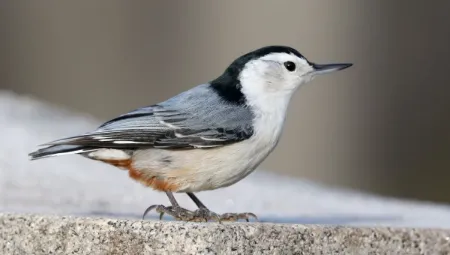
Where in Michigan does it find:
Sitta Carolinensis, the White-breasted Nuthatch is very similar to the White Wagtail in terms of plumage. This bird has a patchy distribution which is found in some parts of Southern Canada.
Description of the bird:
Recognizing the White-breasted Nuthatch bird, this bird is known to be a noisy bird. These nuthatches have a nasal voice which often utters a sound of little cries or vocalizations.
While identifying this bird, it has a compact body, short tail, and long, slender bill. The adult male bird has a glossy black cap, pale blue-gray upperparts, and a black band on the upper back. Their face and underparts are closely observed to be white.
Size of the bird, size of wings, the weight of the bird:
Size: 5.1-5.5 inches (13-14 cm)
Wingspan: 7.9-10.6 inches (20-27 cm)
Weight: 0.6-1.1 ounces (18-30 g)
Habitat and Behavior:
The White-breasted Nuthatch bird is a species of bird found in the nuthatch family of Sittidae. Mainly, the medium-sized nuthatches are found in deciduous forests or mixed woodlands across North America which are of low altitudes.
It also includes parks, suburban gardens, orchards, and cemeteries. When they are foraging for insects, White-breasted Nuthatch effortlessly climbs down the trees. They have a unique habit of moving their headfirst
The downward movement on tree trunks distinguishes them from other nuthatches.
Diet:
They feed on insects such as oyster shells, pine weevils, caterpillars, ants, and seeds.
Notable Locations in Michigan for Viewing:
The best places where White-breasted Nuthatch birds can be starred at like Isle Royale National Park or Huron-Manistee National Forests. The bird lovers can observe these
acrobatic nuthatches among the trees.
Pied-billed Grebe
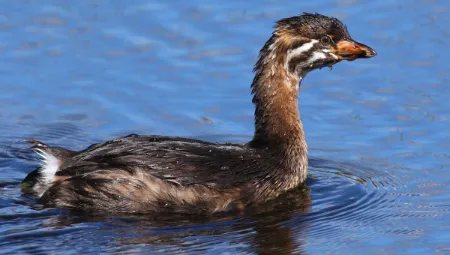
Where in Michigan does it find:
Widely, Pied-billed Grebe is thoroughly distributed in all parts of the Americas. Commonly from North and Central America, the Caribbean, and South America year-round. Pied-billed Grebe is also called a “hell-driver”.
Description of the bird:
The bird, Pied-billed Grebe is small, stocky, and short-necked. Looking at its bill shape, it has a shorter, pointed at the tip, and flattened along the sides. The appearance of Grebe bird has a chunky body and short wings. This bird has its unique call which is similar to the yellow-billed cuckoo that sounds like a “whooping kuk-kuk-cow-cow-cow-cowp-cowp.”
Size of the bird, size of wings, the weight of the bird:
Size: 12-15 inches (30-38 inches)
Wingspan: 18-24 inches (45-62 cm)
Weight: 8.93-20.05 ounces (253-568 g)
Habitat and Behavior:
Grebes are the family of the Podicipedidae. These types of birds are mostly found inhabiting freshwater ponds, lakes, saltwater, and marshes. Primarily, grebes do not have webbed feet. Due to the unavailability of the feet, they are not able to walk on land.
Instead of that, Pied-billed Grebes have lobes that come out of each side of the toe. They are excellent divers. Grebes use their lobed toes for propulsion underwater in search of fish, insects, and aquatic plants.
Diet:
Feeds mainly on aquatic invertebrates, small fish, and amphibians (such as frogs, and tadpoles). Additionally, they also eat their feathers which helps Grebes to aid in digestion. Also, feed their feathers to the younger Pied-billed Grebes.
Notable Locations in Michigan for Viewing:
While exploring the areas in Michigan, Pied-billed Grebe can be observed at Sleeping Bear Dunes National Lakeshore or Shiawassee National Wildlife Refuge.
Black-billed Cuckoo
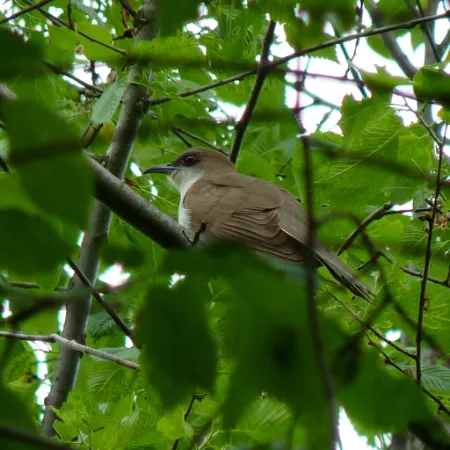
Where in Michigan does it find:
Black-billed Cuckoo species is commonly found in the wooded areas across the United States, east of the Rockies. Mainly, they are present in Eastern North America, Western Nova Scotia, Manitoba, California, and rarely in Western Europe and Greenland.
Description of the bird:
Black-billed Cuckoo are very similar to the Yellow-billed Cuckoo. These cuckoos are obligate brood parasites. Their head and upper parts are brown whereas the underparts are white.
Adult cuckoos have a long, graduated brown tail and a black. It has a slightly downcurved bill which helps them to catch insects. Their feets are zygodactylous.
Size of the bird, size of wings, weight of the bird:
Size: 11.0-12.6 inches (28–32 cm)
Wingspan: 17.5 inches (44 cm)
Weight: 1.6–1.9 ounces (45–55 g)
Habitat and Behavior:
These elusive birds are most commonly found around the edges of mature deciduous or mixed forests. They prefer dense forests, especially areas with caterpillar outbreaks.
Cuckoos can inhabit tropical rainforests, semi-open woodlands as well as scrub forests. Black-billed Cuckoo possesses a remarkable ability to mimic hawks’ calls to deter potential threats from their nests.
Diet:
Their diet consists of mainly insects which include tent caterpillars. Also some of the snails, other birds’ eggs, and berries. In addition, their main source of food is to eat invasive spongy moths.
Notable Locations in Michigan for Viewing:
Some of the areas in Michigan where Black-billed Cuckoo can be spotted are the wooded areas. Such as Porcupine Mountains Wilderness State Park or Pigeon River Country State Forest.
Black-throated Blue Warbler
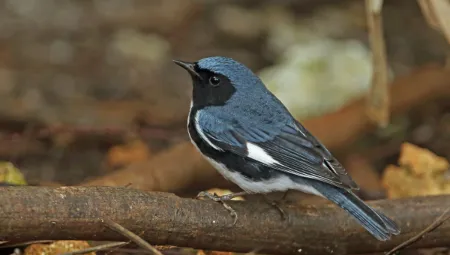
Where in Michigan does it find:
A small passerine bird, the Black-throated Blue Warbler is rarely found in Western Europe. They mostly migrate from islands in the Caribbean and Central America during the winter season.
Description of the bird:
In the New World Warbler family, the Black-throated Blue Warbler can be distinguished by its small white wing patches. These birds are strongly sexually dimorphic birds. The adult male has white underparts with a black throat, face, and flanks.
Similarly, the female Warblers have olive-brown upperparts and light yellow underparts. It also has a gray crown and brown patches on its cheek.
The black-throated blue warbler bird song is buzzed “zee-zee-zee” with an upward inflection. This lovely bird call is a flat ctuk.
Size of the bird, size of wings, weight of the bird:
Size: 4.3-5.1 inches (11-13 cm)
Wingspan: 7.5-7.9 inches (19-20 cm)
Weight: 0.30–0.44 ounces (8.4–12.4 g)
Habitat and Behavior:
Being a migratory species of Warbler birds, they are generally found in deciduous forests or mixed coniferous-deciduous forests with a thick understory. These warblers forage by hopping among branches and foliage in search of insects and berries.
Diet:
The Black-throated Blue Warbler mainly feeds invertebrates such as crane flies, caterpillars, and spiders. It includes supplements during the winter such as fruits, berries, and seeds.
Notable Locations in Michigan for Viewing:
The best places to explore the Black-throated Blue Warbler are to head to Hartwick Pines State Park or Sleeping Bear Dunes National Lakeshore. We can spot these beautiful birds during their migration period.
Common Loon
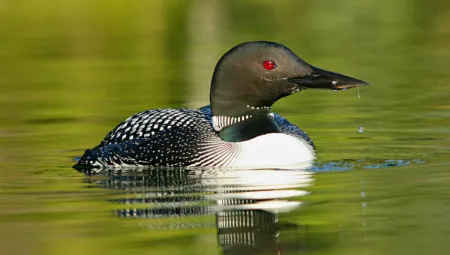
Where in Michigan does it find:
Common Loon bird is also known as the Great Northern Diver in Eurasia. Loons can be seen in the Northern United States and Canada, the Southern part of Greenland, Iceland, Norway Bear Island, and in Alaska.
It is a large member of the loon or diver family of birds. The loon is regarded as the provincial bird of Ontario. This bird also appears in Canadian currency.
Description of the bird:
Common Loon has a sleek black head, a distinctive black-and-white checkered back, and a dagger-like bill. It also has a black bill with a pale tip and red eyes. Loon can be distinguished from the black-throated loon and the red-throated loon.
Some of their common loon vocalizations are Tremolo, yodel, wail, and hoot. Loons call may vary according to the weather, day, and season. Every time it communicates a distinct message from each of their calls.
Size of the bird, size of wings, weight of the bird:
Size: 26.0-35.8 inches (66-91 cm)
Wingspan: 40.9-51.6 inches (104-131 cm)
Weight: 88.2-215.2 ounces (2500-6100 g)
Habitat and Behavior:
Common Loon prefers those areas which are typically found on freshwater lakes during the breeding season.
They rarely visit the Arctic coast. Whereas, most of the loons like to remain in Iceland year-round. Loons is an expert fisher known for catching its prey by diving as deep as 60 m underwater in search of fish. Loons’ behavior is puzzling.
During migration, the Common Loon can swim as well as dive and can fly competently for 100 km. Their haunting calls echo across the waterways.
Diet:
The diet consists of Common Loons are forages on fish, small minnows, insects, fragments of green vegetation, flounder, sea trout, haddock, etc. It also preys on snails, insect larvae, frogs, annelids, and sometimes aquatic plants (willow shoots, algae, pondweed).
Notable Locations in Michigan for Viewing:
The bird lovers can view Common Loons in Michigan’s Northern part of the lakeshores. These majestic birds can be witnessed such as Torch Lake or Higgins Lake during the summer season.
Eastern Kingbird
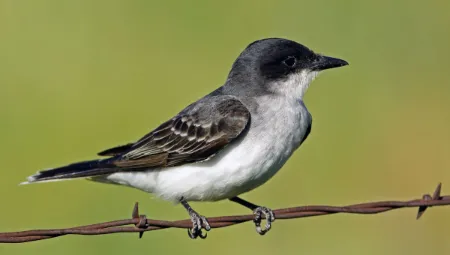
Where in Michigan does it find:
The large tyrant flycatcher, the Eastern Kingbird is native to the Americas. During their breeding season, these birds are found openly across North America. Birds migrate in folks to South America.
Description of the bird:
The aggressive bird, Eastern Kingbird is predominantly dark gray with white underbelly and pointed wings. It boasts a sleek black cap on its head. Kingbirds also have a red patch on their crown.
Generally, the Eastern Kingbird bird call is compared to an electric fence. The bird call is high-pitched, buzzing, and unmusical chirp.
Size of the bird, size of wings, weight of the bird:
Size: 7.5-9.1 inches (19-23 cm)
Wingspan: 13.0-15.0 inches (33-38 cm)
Weight: 1.2-1.9 ounces (33-55 g)
Habitat and Behavior:
Adult Eastern Kingbirds are commonly found in an open area with scattered trees and bushes. They can also be spotted in areas like fields, meadows, and along the edges of water bodies.
These beautiful birds are known for their aggressive behavior. When they are defending their territory against larger birds. Eastern Kingbirds make their nests and even hide their nests. Both sexes actively participate in the nest defense.
Diet:
Eastern Kingbirds’ diet consists of fruit and berries, and try to catch the insects by flying out in flight.
Notable Locations in Michigan for Viewing:
Eastern Kingbirds are mainly explored in areas such as near marshes or open fields in places. Like Pointe Mouillee State Game Area or Shiawassee National Wildlife Refuge to spot these vigilant kingbirds.
Black Skimmer
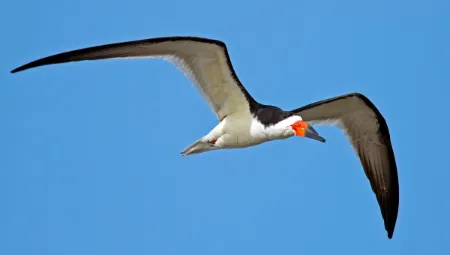
Where in Michigan does it find:
The family of Laridae, Black Skimmer are commonly found in the coasts of the North Eastern United States, down to Mexico, and over to the Gulf Coast of Florida.
Description of the bird:
One of the three skimmer species is the Black Skimmer. This bird has a unique feature: it has a dark brown iris and catlike vertical pupil. Skimmer’s body is black whereas the basal half of the bill is red.
This unique bird has an iconic lower mandible longer than the upper one. While featuring their upper body it strikes black color and a white color is seen in the forehead and underparts. The bird’s call of Black Skimmer is a barking “kak-kak-kak”.
Size of the bird, size of wings, weight of the bird:
Size: 15.8-19.7 inches (40-50 cm)
Wingspan: 42.9-45.3 inches (109-115 cm)
Weight: 9.3-12.9 ounces (265-365 g)
Habitat and Behavior:
Black Skimmers are commonly found in coastal areas, especially near sandy beaches or estuaries. Skimmer spends most of their time loafing gregariously on the sandbars in the rivers, coasts, and lagoons.
Diet:
The light graceful bird, the Black Skimmer usually feeds in large flocks. Their distinctive feeding behavior mainly involves skimming their lower mandibles along the water surface to catch fish, insects, mollusks, and crustaceans.
Primarily, Skimmers feed during low light levels at night. Similarly, during the day they observe the forage for nighttime feeding. It depends on the availability and quality of adequately sized prey which is closely located to the nest site.
Notable Locations in Michigan for Viewing:
Especially, a tern like seabirds, Black Skimmer is occasionally seen from the head to coastal areas. That is around the Great Lakes, like Tawas Point State Park or Whitefish Point.






